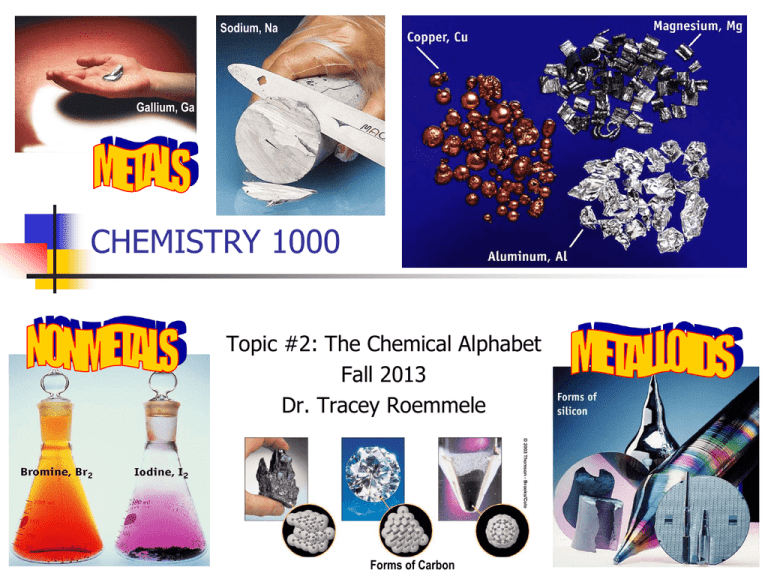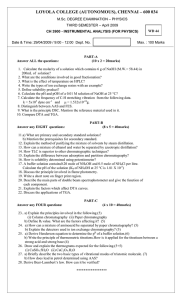CHEMISTRY 1000 Topic #2: The Chemical Alphabet Fall 2013 Dr. Tracey Roemmele
advertisement

Sodium, Na Gallium, Ga CHEMISTRY 1000 Topic #2: The Chemical Alphabet Fall 2013 Dr. Tracey Roemmele Forms of Carbon Chromatography – What Is It? Chromatography is one of the most useful tools for separating mixtures. It can be used on an analytical scale (tiny amounts; we just want to know what each compound is) or on a preparative scale (large amounts; we want to recover at least one component of the mixture). The name “chromatography” comes for the Greek words for “colour” and “to write”. This is because the first examples of chromatography involved separating mixtures into components of different colours (see picture). Chromatography is used in a wide variety of fields including forensics, medicine and athletics (performance enhancer tests) 2 Image from http://commons.wikimedia.org/wiki/File:Chromatography_of_chlorophyll_results.jpg Chromatography – How Does It Work? While there are many different types of chromatography, they all operate under the same basic principles. Every chromatography experiment involves: * A stationary phase, and A mobile phase The mobile phase travels through the stationary phase. As it travels, some components of the sample mixture will be attracted to the stationary phase and spend time adsorbed* to it. Other components of the sample mixture will be less attracted to the stationary phase so will spend most of their time traveling with the mobile phase. This means that each component will take a different amount of time to travel through the experimental apparatus (often a column or coiled tube (which is still called a ‘column’)) “adsorbed” is a word that loosely means “stuck to”. It is not the same as “absorbed”. Consider a sponge. If you dip it in paint, the paint sticks to the surface. The paint is adsorbed to the sponge. 3 On the other hand, if you dunked the sponge in water, it would soak up water. The water would be absorbed by the sponge. Chromatography – What Is It? The schematic below illustrates a mixture of red and yellow compounds in a chromatography column. The schematic at the right shows how this leads to separation of the mixture. Looking at the picture, which of the two compounds has a stronger affinity for the stationary phase? Why? What properties of the compounds determine this affinity? Images from Marc Roussel (upper) and http://commons.wikimedia.org/wiki/File:Chromatography_column.PNG (lower) 4 Chromatography – What Is It? A real-life picture of a chromatography experiment (the colours do not correspond to those on the previous page): In CHEM 1000, we will briefly look at three categories of chromatography experiments: Ion exchange chromatography, Liquid chromatography, and Gas chromatography Image from http://commons.wikimedia.org/wiki/File:Column_chromatography_sample_separation.jpg 5 Ion Exchange Chromatography Recall the ion exchange column used in water softeners… Ion exchange chromatography operates under similar principles. The mixture contains ions with different charges (though they must either all be positive or all be negative) e.g. +1, +2 and +3 The stationary phase consists of beads whose surfaces are covered with ionic residues Positively coated beads are used to separate mixtures of anions Negatively coated beads are used to separate mixtures of cations Images from Marc Roussel 6 Ion Exchange Chromatography The mixture of ions is dissolved in the mobile phase (often starts as water) and the ions stick to the stationary phase. Once the ions are all stuck to the stationary phase, salt is added to the mobile phase. Initially, a low concentration of salt is used – just enough to displace the ions with low charges. Slowly, the concentration of salt is raised. As the salt concentration increases, ions with higher charges are successively displaced: Not all ions are as simple as Na+, Mg2+, etc. This technique is also useful for separating large ions such as proteins. If all experimental conditions are kept the same, a protein will always elute (come out of the column) at the same salt concentration. 7 Which intermolecular forces are most important to this technique? Liquid Chromatography The term “liquid chromatography” refers to the fact that the mobile phase is a liquid (passing through a solid stationary phase). The photo on page 5 of these notes shows an example of liquid chromatography. You may have heard the abbreviation HPLC. (If you go on to take biochemistry, you’ll almost certainly encounter it there.) HPLC stands for High Performance Liquid Chromatography. It is an extremely useful analytical technique for separating mixtures and, when properly calibrated, can also be used to identify components of a mixture and measure quantities of each component. 8 Liquid Chromatography Liquid chromatography separates mixtures based on the polarity of each component. In normal phase liquid chromatography, the stationary phase is polar (see image). The mobile phase is relatively nonpolar. In reversed phase liquid chromatography, the stationary phase is coated with a nonpolar layer. The mobile phase is polar. Why would we need both options? When would we use each? Consider the relevant intermolecular forces… 9 Gas Chromatography GC/MS is short for Gas Chromatography Mass Spectrometry – a very useful technique in a variety of fields including forensics. The term “gas chromatography” refers to the fact that the mobile phase is a gas (passing through a liquid stationary phase). The liquid stationary phase either coats the inside of a *very* narrow capillary or is coated on an inert solid packed inside the capillary. Figure 22.33. Gas chromatographs. 10 Gas Chromatography The sample mixture is injected into the instrument and vapourized. The mixture can then be carried through the column by the gaseous mobile phase. It is common for the temperature of the column to be slowly increased as the experiment progresses. Based on what you’ve learned so far, why can components of a mixture can be separated by gas chromatography? 11





